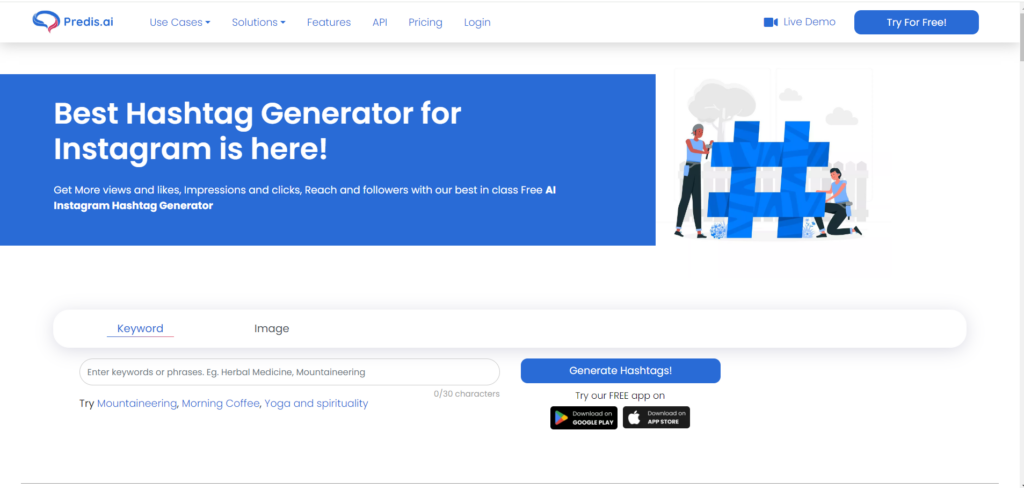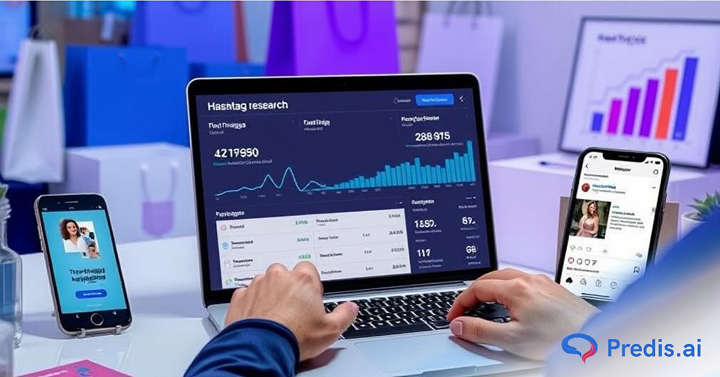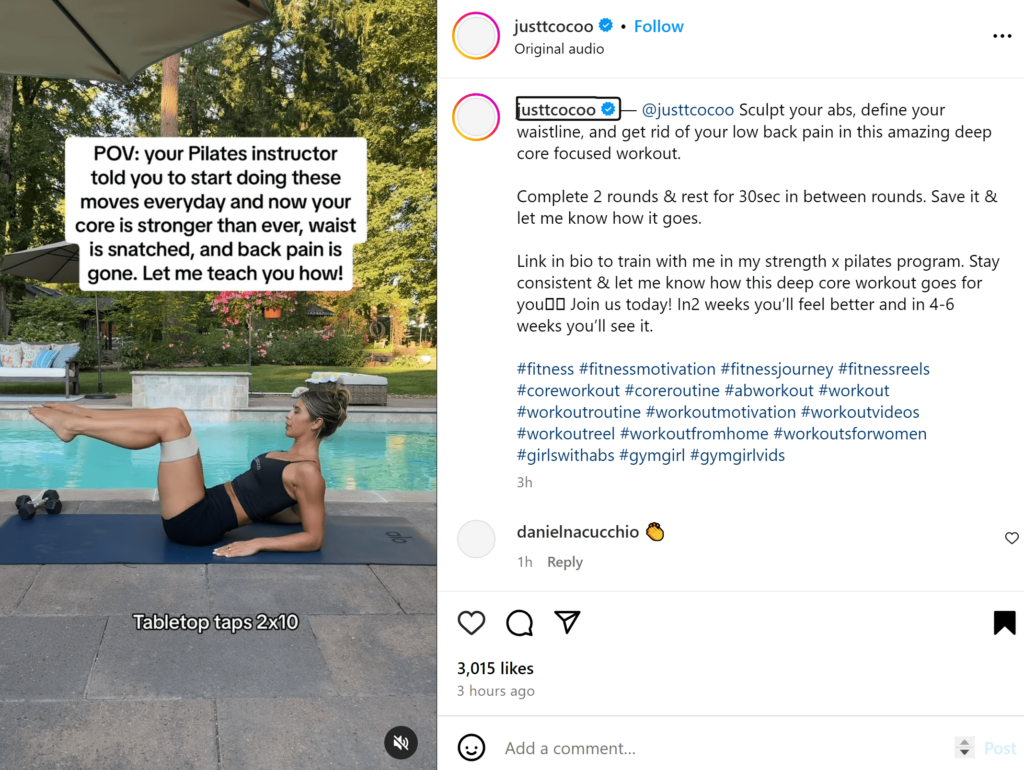Do you find it difficult to get your e-commerce brand noticed on social media? Well, hashtags can be the answer to getting more visibility and engagement. In the noisy digital marketplace, proper usage of hashtags is crucial if you want your brand to reach eyes on platforms like Instagram, Twitter, and Facebook. Strategic research and the best use of hashtags bring forth an authentic connection with your audience, which is not just a driver for traffic but also sharing meaningful conversations with your brand.
Hashtag research allows one to pinpoint the tags that gain views and engage relevant audiences most actively. This blog will discuss the importance of hashtag analytics and research tools, which will allow you to level up your social media strategies for optimal reach and impressions.
Understanding the Role of Hashtags in E-commerce
Hashtags serve as beacons in the vast sea of social media. It will lead all of your content to the shores of your intended audience. Competition is tough in the arena of e-commerce, and fights for visibility are fierce; knowing the strategic use of hashtags can take your brand’s game to a whole new level.
Enhancing Visibility and Engagement
Hashtags are powerful tools for segmenting content and reaching niche groups. For instance, a well-placed hashtag can increase post visibility exponentially. The importance of hashtags is capturing attention and fostering interaction with your content.
Impact on Target Audiences and Sales
Well-researched hashtags are invaluable when it comes to reaching specific demographics. They act like targeted ads without the hefty cost. For e-commerce businesses, this means that using the right hashtags can directly influence the discovery of potential customers. Wider reach is important for driving conversions and serves as evidence that a close relationship between strategic hashtag use and increased sales is possible.
Moreover, hashtag analytics can be useful for performance and trend insights through various tools. These tools can track hashtag reach and impressions, offering a clear picture of how hashtags contribute to campaign goals.
Basics of Hashtag Research
Hashtag research is a foundational strategy in e-commerce social media marketing, which is important for reaching effective segments of consumers. This involves identifying, analyzing, and selecting hashtags that increase the visibility of social media posts to potential customers.
What is Hashtag Research?
At its core, hashtag research can be seen as a strategic choice of keywords that are most likely to connect your content with an interested audience through social media platforms. It is more about discovering hashtags that your target customers follow and interact with.
Why is Hashtag Research Critical for E-commerce?
In e-commerce, where the fight for attention is high, the right hashtags can put your products in front of potential buyers’ eyes. According to the TrackMaven research, posts with nine hashtags receive, on average, 2.5 times more engagement than those with one hashtag. This statistic underscores the importance of hashtags and the importance of using them wisely to maximize reach and engagement.
Initial Steps in Hashtag Research
- Identify Industry-Relevant Hashtags: Begin by creating a list of general keywords related to your e-commerce industry. Different tools like Predis.ai and Hashtagify can help you find such hashtags. These tools are search mechanisms and also provide information on hashtag popularity and reach.
- Analyze Competitor Tags: Look at your competitors’ tags, especially those that have good engagement rates. This can give you a clue as to what might work for your own.
- Use Hashtag Research Tools: Various tools provide analytics on hashtag performance, such as how often it is used, its reach, and what demographic is engaging with it. This gives you key information about which tags are more likely to do well with your target audience.
- Test and Evaluate: Once you have made your choice on your hashtags, track them over time. Look at engagement levels on posts with different hashtags to optimize and choose the best performers in the future.
Streamline your hashtag research with the Predis.ai Hashtag Generator tool, which is perfect for discovering impactful hashtags to boost your e-commerce visibility.
Tools for Effective Hashtag Research
In this digital age, using the right tools for hashtag research is crucial to the success of social media marketing for any e-commerce business. These tools will help you identify trending and relevant hashtags. At the same time, they will show you how these hashtags are performing and guide you in optimizing your social media strategy for maximum engagement.
Hashtag analytics tools are special software built to analyze the usage and performance of hashtags across multiple social media platforms. With these, you can identify both trending hashtags and those that are newly gaining ground, monitor their reach, and estimate the engagement they spark.
Using these tools effectively can bring about a big change in your social media marketing endeavors and drive much more targeted traffic to your e-commerce store.
Key Tools for Hashtag Research and Analytics
1.Predis.ai
Predis.ai simplifies the process of finding high-performing hashtags for your Instagram posts. By entering keywords that describe your post, such as ‘Real Estate’, our AI analyzes Instagram to uncover the most effective hashtags related to your input.
How to Use:
- Input Keywords: Inform our AI tool about your post using keywords. Whether your focus is travel, food, technology, science, sports, or any other niche, our AI can find relevant hashtags for every niche.
- Upload Image: Enhance your hashtag research by downloading a picture that would complement your post. Our AI uses image recognition technologies to suggest related hashtags that will fit your posts, allowing your content to be found and look even more engaging.

2. Hashtagify
This tool enables the user to look up hashtags and get an idea of what those hashtags mean in terms of popularity and related tags. It will show you in-depth data about the trend of hashtag use and who is exactly using them.
How to Use:
Enter a keyword related to your e-commerce niche in Hashtagify to find the related hashtags. Check the popularity and correlation data to choose very relevant but broad-reaching hashtags.
3. RiteTag
RiteTag is a tool that provides instant suggestions for hashtags based on the content you provide. Real-time feedback on hashtag strength gives you the guidance you need to make the pick that is most probably going to make your post shine much brighter.
How to Use:
Upload a draft of your social media post or input text into RiteTag, and it will suggest effective hashtags. Categories suggestions to show how many hashtags will help you get seen now and which are for long-term visibility.
4. Keyhole
Real-time hashtag tracking with data such as reach, impressions, and top posts mentioning the hashtags. It is the best for following up on campaigns and understanding the engagement level of audiences.
How to Use:
Enter a hashtag on Keyhole to monitor how it’s performing on platforms like Twitter, Instagram, and Facebook. Use the analytics dashboard to monitor your reach and level of engagement and apply what you have learned to iterate your hashtag strategy.
Analyzing Hashtag Performance
It’s important to analyze the performance of hashtags for fine-tuning your e-commerce social media strategy. Find out which hashtags are most effective in giving reach and impression, and then focus on them for better engagement. This involves tracking various metrics provided by hashtag analytics tools and interpreting data into knowledgeable decisions.
How to Track Hashtag Effectiveness
1. Use Hashtag Analytics Tools: Many analytics tools, such as Keyhole and Hashtagify, offer detailed tracking for hashtags. This information is critical in understanding the hashtag reach and usage.
2. Monitor Reach and Engagement: Reach measures the number of unique users who have seen your hashtag, while engagement measures the interaction that the users have had with posts, including likes, shares, and comments. These are metrics you need to monitor in order to understand what direct impact certain hashtags can have on audience engagement.
3. Evaluate Hashtag Trends: Some tools give you data trends over time, which lets you see if the hashtag is becoming popular or not. This is vital to catch rising trends early or avoid diminishing ones.
Tips on Interpreting Hashtag Analytics
Here, we dive into the best practices for interpreting hashtag analytics to optimize your social media strategies:
- Compare Performance Metrics: Look at how different hashtags perform against each other in terms of reach and engagement. A higher reach does not always equate to more engagement, so finding a balance that increases both is key.
- Contextualize with Events and Campaigns: Consider the context in which certain hashtags are used. A spike in hashtag performance might be tied to specific campaigns or events. Understanding this context can help you replicate successful strategies.
- Look for Audience Insights: Most analytics tools provide demographic information of users who are engaging with your hashtag. Use this to make a more refined segment of the audience you intend to reach and further tailor that content more specifically to the tastes of the audience.
- Continuous Monitoring and Adjustment: Hashtag performance can easily change with changing trends and user behavior. Since you monitor your hashtag strategy on a regular basis, this will provide a navigational course to adapt based on the most current data. This provides agility in ensuring that your content remains relevant and engaging.
Create compelling videos that engage and attract your target audience using Predis.ai Social Media Video Maker.
Crafting a Hashtag Strategy for Your E-commerce Brand
A hashtag strategy for your e-commerce brand must be a good mix of both popular and trending hashtags balanced with some niche hashtags. This strategy guarantees that your social media posts receive maximum visibility in the right audience. Below is a step-by-step guide to developing such a hashtag strategy for your e-commerce project.
Step 1: Set Clear Objectives
Start with clear objectives: What do you want to achieve through a hashtag? Brand awareness, sales volumes, and traction in a certain section of your audience should be the backbone of any objective for hashtags. Objectives of hashtags will guide your choice and measure the success of your strategy.
Step 2: Research and Select Hashtags
- Popular Hashtags: Start with popular hashtags that have a broad appeal and are frequently searched. These are general and can increase the reach of your posts. However, because they are highly competitive, they should be used judiciously.
- Trending Hashtags: Incorporate trending hashtags that relate to current events or popular discussions within your industry. These can provide a temporary boost in visibility. Tools like Trendmap and Twitter’s trending topics can help identify these hashtags.
- Niche Hashtags: These are specific to your industry and are crucial for targeting a dedicated audience interested in your products. Niche hashtags have less competition and a more engaged audience, making them valuable for driving conversions.
Step 3: Combine and Implement
Mix these hashtags in a balanced way within your posts. As a general rule of thumb, one or two should be popular hashtags, along with a couple of trending ones if relevant, and several niche hashtags to anchor the visibility of your content in your specific market.
Step 4: Monitor and Adjust
Use hashtag analytic tools to keep an eye on your hashtags’ performance in terms of reach and engagement. Adjust your strategy based on what works. For instance, if certain niche hashtags consistently perform well, consider focusing more on those.
Step 5: Stay Updated
Hashtag trends can change quickly. Regularly update your strategy to include new relevant hashtags. This ensures that your content is fresh and remains engaging to your target audience.
According to Agropulse, Instagram posts with at least one hashtag receive 70% more likes than those without any hashtags. This data underscores the importance of a well-rounded hashtag strategy in enhancing your brand’s engagement and visibility.
Best Practices for Using Hashtags in E-commerce Posts
In order to strategically use hashtags, use best practices illustrated by real-life examples.
- Relevance: Include only those hashtags that best align with your post content and brand voice. This ensures that your posts reach the right audience and lead to meaningful interaction.
- Use a Mixture of Hashtags: A mixture of popular, trending, and niche hashtags will balance the reach and relevance of the post. For example, #fashion is generic, but #vintagedenimjackets is more niche and a lot more likely to draw a very specific audience.
- Make It Simple and Memorable: Use simple, easy-to-remember hashtags that are also easy to spell. This increases the chances of people using them when making their posts.
- Title Case: Use this for hashtags composed of more than one word to ensure that the message is clear and readable. An example is #SummerFashionDeals.
- Avoid Overstuffing: Too much use of hashtags renders your posts spammy. It is, therefore, counterproductive and less engaging. You can use up to 30 on Instagram, but 9 to 11 have shown to give the most engagement.
- Too Generic: Popular hashtags are popular for a reason, with broad reach, but they can often be highly competitive and not necessarily deliver quality engagement. Personalize your hashtags based on your brand and your audience.
- Ignoring Hashtag Analytics: Never underestimate performance. Use the analytics to understand which tags work best and adjust your strategy accordingly.
Case Studies
1. Zara
One of the leading fashion brands, Zara, effectively uses hashtags like #ZaraNewCollection. These hashtags categorize their posts and engage fashion enthusiasts looking for the latest trends. Their focused approach helps them reach customers interested specifically in new releases, driving both reach and conversion.
2. Airbnb
Airbnb uses hashtags like #AirbnbExperiences to highlight unique stays and experiences offered through their platform, boosting engagement and providing social proof. This approach attracts more users to Airbnb’s platform as hosts and guests share their experiences using this hashtag, which enhances Airbnb’s brand presence on social media.
Enhance your social media visuals with Predis.ai Ecommerce Social Media Post Maker, designed to integrate your newly researched hashtags seamlessly.
Conclusion
Throughout this guide, we touched on how potent properly researched hashtags are in changing the visibility and activity of your e-commerce brand on social media. With strategic use of hashtag analytics tools, ways to find the mix of popular, trending, and niche hashtags, and best practices when using them, you will be able to increase your social media strategy by good levels.
Now is the time to start using these hashtag research techniques. Begin analyzing, experimenting, and refining to find the perfect combination of hashtags that lure potential followers into your store. Do this in order to expand your reach and make valuable connections with your audience, hence boosting sales.
Ready to take your social media marketing to the next level? Try Predis.AI tools to seamlessly incorporate your top-performing hashtags into stunning ads. Take action today, and watch your e-commerce brand thrive in the digital marketplace.


















